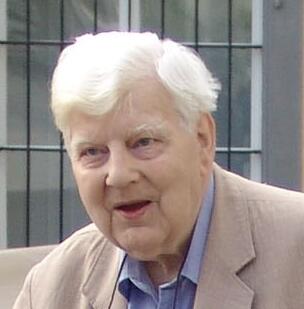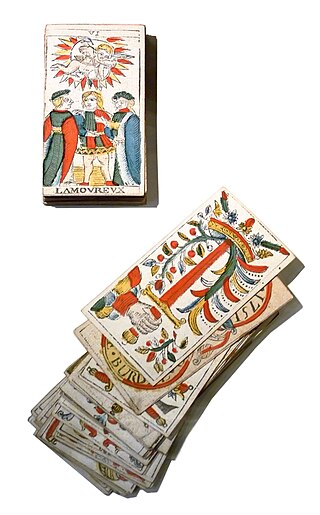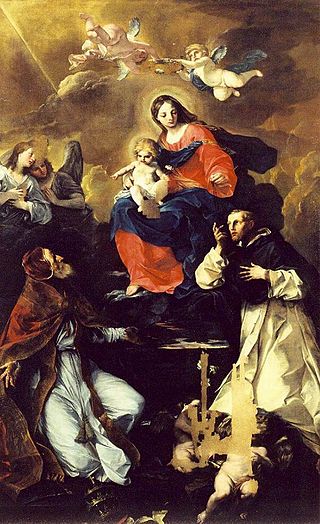
The tarot is a pack of playing cards, used from at least the mid-15th century in various parts of Europe to play card games such as Tarocchini. From their Italian roots, tarot playing cards spread to most of Europe evolving into a family of games that includes German Grosstarok and more recent games such as French Tarot and Austrian Königrufen which are still played today. In the late 18th century, French occultists began to make elaborate, but unsubstantiated, claims about their history and meaning, leading to the emergence of custom decks for use in divination via tarot card reading and cartomancy. Thus there are two distinct types of tarot pack: those used for playing games and those used for divination. However, some older patterns, such as the Tarot de Marseille, originally intended for playing card games, have also been used for cartomancy.

Sir Michael Anthony Eardley Dummett was an English academic described as "among the most significant British philosophers of the last century and a leading campaigner for racial tolerance and equality." He was, until 1992, Wykeham Professor of Logic at the University of Oxford. He wrote on the history of analytic philosophy, notably as an interpreter of Frege, and made original contributions particularly in the philosophies of mathematics, logic, language and metaphysics. He was known for his work on truth and meaning and their implications to debates between realism and anti-realism, a term he helped to popularize. He devised the Quota Borda system of proportional voting, based on the Borda count. In mathematical logic, he developed an intermediate logic, already studied by Kurt Gödel: the Gödel–Dummett logic.

The Tarot of Marseilles is a standard pattern of Italian-suited tarot pack with 78 cards that was very popular in France in the 17th and 18th centuries for playing tarot card games and is still produced today. It was probably created in Milan before spreading to much of France, Switzerland and Northern Italy. The name is sometimes spelt Tarot of Marseille, but the name recommended by the International Playing-Card Society is Tarot de Marseille, although it accepts the two English names as alternatives. It was the pack which led to the occult use of tarot cards, although today bespoke cards are produced for this purpose.

The Visconti-Sforza Tarot is used collectively to refer to incomplete sets of approximately 15 decks from the middle of the 15th century, now located in various museums, libraries, and private collections around the world. No complete deck has survived; rather, some collections boast a few face cards, while some consist of a single card. They are the oldest surviving tarot cards and date back to a period when tarot was still called Trionfi cards, and used for everyday playing. They were commissioned by Filippo Maria Visconti, Duke of Milan, and by his successor and son-in-law Francesco Sforza. They had a significant impact on the visual composition, card numbering and interpretation of modern decks.

Trionfi are 15th-century Italian playing cards with allegorical content related to those used in tarocchi games. The general English expression "trump card" and the German "trumpfen" have developed from the Italian "Trionfi". Most cards feature the personification of a place or abstraction.

Roberto Abbado is an Italian opera and symphonic music conductor. Currently he is Artistic Partner of The Saint Paul Chamber Orchestra. In 2015 he has been appointed Music Director of Palau de les Arts Reina Sofia in Valencia, Spain. From 2018 he's Music Director of the Festival Verdi in Parma. Previously he held the position of Chief Conductor of Münchner Rundfunkorchester.

Felice Torelli was an Italian painter of the Baroque style, active mainly in Bologna.
Gianfranco Goberti is an Italian painter. After studying Arts at the Institut Dosso Dossi in Ferrara, Italy, and at the Academy of Art in Bologna, he was teacher and Director of the Institut of Arts Dosso Dossi. His first exhibition was held in 1959 with references to Picasso and Bacon. His research dealt with nuova figurazione and Abstract Expressionism. The first optical-figurative period starts during the 1960s. In 1980, he was selected by the National Catalogue of Modern Art Bolaffi together with Paolini, Adami, Bulgarelli, Cassano and Paladino. Goberti has held exhibitions at the International Art Expo of Bilbao, Quadriennale d'Arte in Rome, Rassegna Premio S. Fedele (Milan), Arte Fiera (Bologna), Altissima (Turin), Expo Arte (Bari), ArteExpo (Barcelona), and LineArt (Ghent), "La Venere svelata – La Venere di Urbino di Tiziano".
The Tarocco Piemontese is a type of tarot deck of Italian origin. It is the most common tarot playing set in northern Italy, much more common than the Tarocco Bolognese. The most popular Piedmontese tarot games are Scarto, Mitigati, Chiamare il Re, and Partita which are played in Pinerolo and Turin. This deck is considered part of Piedmontese culture and appeared in the 2006 Winter Olympics closing ceremony held in Turin. As this was the standard tarot pack of the Kingdom of Sardinia, it was also formerly used in Savoy and Nice before their annexation by France. Additionally, it was used as an alternative to the Tarocco Siciliano in Calatafimi-Segesta, Sicily. Outside of Italy, it is used by a small number of players in Ticino, Switzerland and was used by Italian Argentines.
Ferenc Pinter was an Italian painter and illustrator.
Sergio Zanni is an Italian painter and sculptor. After obtaining the Diploma at the Institute of Arts 'Dosso Dossi' in Ferrara, Italy, he graduated from the Academy of Arts in Bologna. He taught in the Institute of Arts 'Dosso Dossi' until 1995. For his research in sculpturing he utilized backed clay and, successively, lighter material for sculptures of large dimensions.

Tarot games are card games played with tarot decks, that is, decks with numbered permanent trumps parallel to the suit cards. The games and decks which English-speakers call by the French name Tarot are called Tarocchi in the original Italian, Tarock in German and various similar words in other languages. The basic rules first appeared in the manuscript of Martiano da Tortona, written before 1425. The games are known in many variations, mostly cultural and regional.

The Bologna–Ancona railway is an Italian railway that connects the city of Bologna with the city of Ancona, passing through the Po Valley to Rimini and along the Adriatic coast for the rest of the line.
Luigi Maria Viviani was an Italian composer, conductor and violinist of Florentine origin. He was primarily noted for his ballet scores, most of them composed for the choreographers Giovanni Galzerani and Antonio Cortesi. His 1851 score for Fausto was particularly praised for its obbligato written for the bimbonclaro.
Dal Negro is an Italian company that produces playing cards, tarot cards, divination cards, chess, backgammon, roulette wheels, and toys for children.

The Tarocco Bolognese is a tarot deck found in Bologna and is used to play tarocchini. It is a 62 card Italian suited deck which influenced the development of the Tarocco Siciliano and the obsolete Minchiate deck.

Giuseppe Maria Mitelli (1634–1718) was an Italian engraver and painter of the Baroque period. He was the son of the prominent quadratura painter Agostino Mitelli. The younger Mitelli was best known for his prolific engravings, in a great variety of subjects, including scenes from grand epics to mundane page boards for games of chance using dice, Tarot cards, and an Iconophor with anthropomorphized alphabets. He also engraved genre subjects, allegories, moralistic scenes, but even some bizarre cartoons that could be interpreted as sometimes provocatively subversive, or presciently revolutionary, and sometimes imaginatively bizarre. He often depicted dwarfs engaged in buffoonery or satirical depictions of aphorisms, which recalls the Bambocciate di nani or arte pigmeo of genre painter Faustino Bocchi (1659–1742).

The Sola Busca tarot is the earliest completely extant example of a 78-card tarot deck. It is also the earliest tarot deck in which all the plain suit cards are illustrated and it is also the earliest tarot deck in which the trump card illustrations deviate from the classic tarot iconography. Unlike the earlier Visconti-Sforza tarot decks, the cards of the Sola Busca are numbered. The Trump cards have Roman numerals while the pips of the plain suits have Hindu Arabic numerals.The deck was created by an unknown artist and engraved onto metal in the late 15th century. A single complete hand-painted deck is known to exist, along with 35 uncolored cards held by various museums. The deck is notable not only for its age, but also for the quality of its artwork, which is characterized by expressive figures engraved with precise contours and shading. Various theories have been suggested about who created the deck, but its authorship remains uncertain.
Claudio Bonoldi was an Italian tenor.












